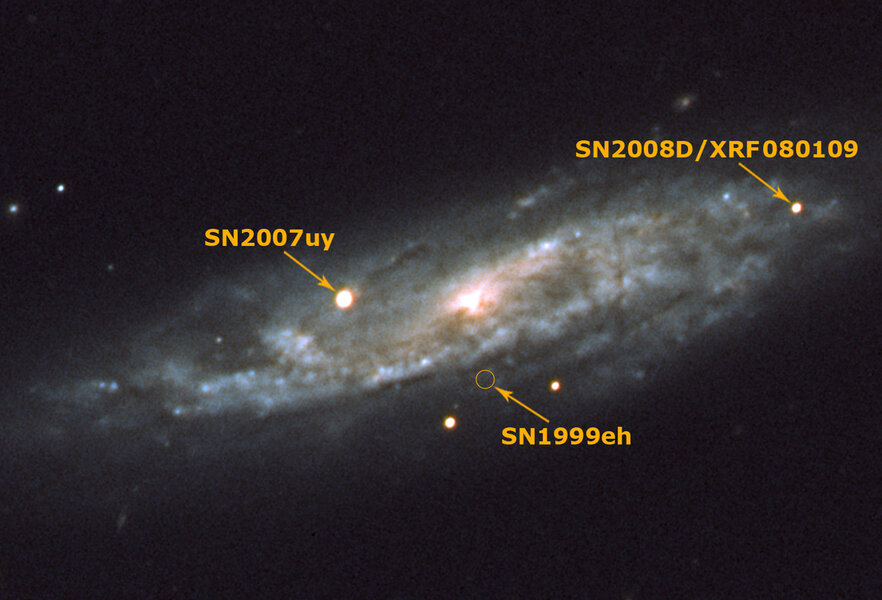Seconds after star explodes, scientists watch young supernova
Loading...
The final, spectacular explosion of a dying star in a galaxy 90 million light-years away may help usher in a new era in understanding these blasts – among the universe’s most violent events.
Astronomers announced Wednesday that they spotted the star in its death throes seconds after the blast and days before it would usually be detected. Supernovae play a key role in seeding the universe with most of its chemical elements. Scientists hope one day to understand the precise mechanism that causes these huge explosions, guided by the technique that allowed the research team to detect Supernova 2008D so early.
“This is the youngest supernova we’ve ever seen,” says Roger Chevalier, an astrophysicist at the University of Virginia, referring to the explosion’s evolution. He was not involved in the research.
Using an orbiting observatory dubbed SWIFT, the team spotted SN 2008D through the explosion’s fledgling X-ray signature. The finding confirms for the first time a longstanding hypothesis that X-rays would be the first radiation this type of supernova would emit – appearing before visible light. (Both forms of radiation took some 90 million years to reach Earth.)
In this case, scientists were able to see the supernova a scant nine seconds after the blast’s shock wave punched through the star’s surface.
The X-ray data contain important clues as to the kind of star that blew up – in this case, an object known as a Wolf-Rayet star, roughly the size of the sun but with 30 times more mass. It lies in a galaxy designated NGC 2770, which appears in the Northern Hemisphere constellation Lynx. Its discovery could lead to a supernova early-warning system that some astronomers say could help revolutionize the study of these events.
A new generation of orbiting X-ray observatories is on the drawing boards, designed to search the skies for telltale signatures from black holes and active galaxies. If this latest discovery is any indication, “these satellites are going to find a lot of supernovas, too,” at similarly early stages of detonation, says Alicia Soderberg, an astrophysicist at Princeton University who led the international team formally reporting the discovery in Thursday’s issue of Nature.
Such detections – perhaps one supernova per day – would allow ground-based radio and optical telescopes to track more of these events far earlier than they ordinarily can. Typically, they catch on to a supernova days after the blast, when its visible light grows bright enough to outshine its host galaxy. Astronomers picked up the first faint glimmers of visible and ultraviolet light from SN 2008D less than two hours after the blast.
And the X-ray signature yields a more precise timing for a blast. This would allow scientists, using exotic tools such as gravity-wave and underground neutrino detectors, to search back through their data for a supernova’s signature as well. Such exotic signatures, generated at the very instant the star explodes, are thought to hold the key to understanding in detail the mechanism that drives these blasts – details that so far have proved elusive.
The early warning on SN 2008D has been invaluable, notes Maryam Modjaz, an astronomer at the University of California at Berkeley who has been working with another international team to track the progress of SN 2008D with ground-based telescopes.
Because the star that exploded was so compact, most of its radiation comes out as X-rays, she says. Still, the additional observations of radiation at longer wavelengths help confirm that it was indeed a supernova, and not some other X-ray source. They also fill in details about the elements the star has shed and their relative abundance, as well as information that helps astronomers determine what the original star was like.
Meanwhile, radio telescopes are helping to fill in information about the makeup of the region surrounding the star, as well as the history of the material the star shed before the blast.





